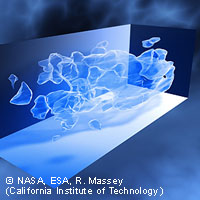Astronomers present first 3D map of dark matter
Scientists from the US, France, Germany and Japan have succeeded in assembling the first three-dimensional map of dark matter in the Universe. It is easy enough for astronomers to see planets, stars and galaxies in the night sky, as these are constructed from ordinary matter. However, these account for only one sixth of the Universe's total mass. The remainder comprises mysterious dark matter, which neither emits nor reflects light. Although invisible, dark matter is extremely important, and is believed to be the glue that holds the Universe together. The European Space Agency (ESA) describes the mapping challenge thus far: 'For astronomers, the challenge of mapping the Universe has been similar to mapping a city from night-time aerial snapshots showing only streetlights. These pick out a few interesting neighbourhoods, but most of the structure of the city remains obscured.' The map was derived from the largest survey ever made of the Universe, carried out using the Hubble Space Telescope. Hubble photographed 575 slightly overlapping views of the Universe, which took nearly 1,000 hours. The result shows that normal matter, largely in the form of galaxies, accumulates along the densest concentrations of dark matter. It reveals a loose network of filaments, intersecting in massive structures where clusters of galaxies are located. This is consistent with conventional theories of how structure formed in the evolving Universe under the pull of gravity. 'It's reassuring how well our map confirms the standard theories for structure formation,' said Richard Massey of the American Astronomical Society in Seattle.



